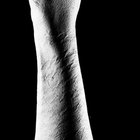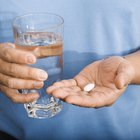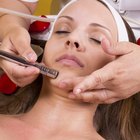
Jupiterimages/Comstock/Getty Images
Amino acids have been used for years in treating skin that has been scarred by acne or stretchmarks. Applied topically, they have the potential to drastically improve skin's appearance.
Amino Acids and Skincare
Amino acids are a buzzword in the world of skincare. Simply put, amino acids are peptides. These are proteins that have been studied extensively and have been determined to have a rejuvenating effect on skin cells. There are four amino acids that are effective in building collagen (the method by which the body repairs scars and stretchmarks): proline, glycine, leucine and lysine. Combined or alone, these acids work as an exfoliant to repair blemished skin.
Acne Scars
Amino acids are one of the most common over-the-counter cures for acne scars. Amino acids are primarily used in microdermabrasion, the medical term for exfoliation. Microdermabrasion encourages rapid cell turnover and regeneration by painlessly removing the top layer of surface skin cells, which are usually dead. Eliminating the dead cells helps new cells to grow in their place, which promotes healing of the skin. Amino acids aid skin in sloughing off the outer layer of dead cells.
Amino acids also promote the rebuilding of collagen, the natural element found in the dermis (layer of skin) that causes skin to maintain its elasticity and resilience. With increased collagen in the dermis, the skin is more likely to heal scars.
Amino acids help to diminish the appearance of acne scars by lightening darkened or reddened scar tissue.
Stretchmarks
Stretchmarks occur when the skin is stretched too quickly. They often appear as red or purple thin lines on the skin, and lighten over time. These marks are the result of actual tears in the skin's dermis layer. The dermis is made up of a mesh of collagen fibers that support skin's elasticity and resilience. When skin is stretched too quickly, this supportive mesh rips, and a stretchmark appears.
Once stretchmarks are present, they usually remain on skin for life, but certain ingredients in over-the-counter creams have been proven effective in drastically lightening these marks.
Amino acids, which are often the foundation of wrinkle-fighting peptides, can diminish the depth and length of stretchmarks. Collagen and elastin, which is found in nearly all stretchmark-treatment creams, then penetrates deeper into the skin's layers, repairing the connective mesh from the inside.
Elastin is the component of skin that allows it to stretch without leaving marks behind. As the body ages, elastin production naturally decreases; when skin stretches, it is more likely to leave a mark because it tears easily. Look for a cream rich in amino-acid-derived elastin to combat stretchmarks effectively.
Creams containing amino acids and clinically proven to reduce stretchmarks are Strivectin-SD and Elastin3.
Related Articles

Skin Care Products That Contain ...

Collagen & Rosacea

Glucosamine: Skin Benefits

Can Tri-Luma Be Used to Fade Acne Scars?

Homeopathy Cure for Stretch Marks

Urea & Acne

Can Age Spots Be Reversed?

What Is Palmitoyl Oligopeptide?

How to Reduce Acne Inflammation

Kojic Acid for Dark Circles

Elastin Supplements

Benefits of Shea Butter and Coconut Oil ...

Are There Foods That Heal Age Spots?

Bromelain & Bruising

How to Lighten Birthmarks

Chasteberry for Acne

Can You Reduce Collagen Production?

Glycolic Acid for Stretch Marks

L-Arginine & the Skin

Fraxel Laser Treatment Dangers
References
Writer Bio
Kristen Hampton has been writing professionally since 2003, specializing in higher-education communications. Her work has appeared in the "Baltimore Sun" and publications for Loyola University Maryland, Drexel University, Lehigh University, Cabrini College and Royal Caribbean International. Hampton lives in Philadelphia.
Photo Credits
Jupiterimages/Comstock/Getty Images